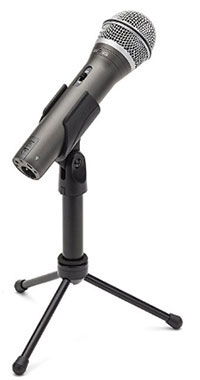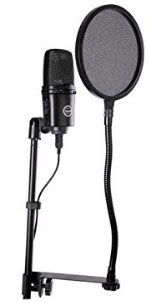
Here is my review of the Samson Q2U microphone. They call this, more specifically, the “Q2U Recording and Podcasting Pack.”
If you don’t want the gory details, I’ll tell you the results of the review right here. The Q2U is excellent! It’s better than the Q1U by a lot and it is almost as good as the Shure SM58 dynamic mic, which costs a lot more.
If you do want to know a bit more…
What is it?
The Q2U is a USB/XLR dynamic microphone. See our post Condenser vs Dynamic Microphones for more on what it means to be a dynamic mic. But what in the world is a “USB/XLR” mic?
Most folks are familiar with what USB microphones are. They are pretty amazing. You don’t need an external interface to plug it into your computer. You just plug the microphone’s USB cable straight into the computer. The sound quality is leaps and bounds better than the traditional direct-to-computer mics that came before. You know, the kind with the little 1/8th inch pin that you stick into your computer’s sound card?
But what about “XLR?”
Standard microphones are typically much higher quality than any direct-to-computer mics. But you need extra gear to get them to connect to your computer. At a minimum, you need:
- A premplifier – microphones need amplification to be made audible
- An analog-to-digital converter – microphones capture “regular audio” (sound waves in the air) and preamps make that louder louder. But that captured sound needs to be converted to “computer language” before you can do anything with it. That is what a converter does. See our post What is An AD Converter? for more on that.

Fortunately, these days most “interface” units (such as the Focusrite Scarlett and at least a dozen similar products) contain both the preamp and converters in a single unit. They are amazingly affordable in 2017. For instance, the Focusrite Scarlett Solo is only about $100.
The XLR mic/interface box combo is basically the same setup used in high-end commercial recording studios. So if you can afford to jump on that train when starting out, I recommend that. The minimum investment there would be in the $175-$200 range.
If your budget isn’t quite there yet though, I usually recommend starting with a USB mic. You can get fantastic value for money that way. The mic I have been recommending as the lowest end still capable of professional sound has been the Samson Q1U mic for $49. But based on the tests I did for this review, I’m changing that to the newer Samson Q2U.
So Spill The Beans Already!
OK, to the results of the review. The short answer is – the Samson Q2U is better than the Q1U by a lot!
I suppose you want some details, right? Here they are.
- The Q2U is only $59 ($54.99 on with Amazon Prime), which is only $10 more than the Q1U.
- With the Q2U, Samson have somehow managed to all but eliminate the steady hiss that is so common in USB mics. This is huge! You can listen below to the difference in the “self-noise” (hiss) of both mics.
- Overall the sound quality is much better
- And it can be used as EITHER a USB mic or an XLR mic!
The Review
I compared the Q2U with both the Q1U AND the most common standard (XLR) dynamic mic in the world, the Shure SM58.
P-Pops
I did not use a pop filter or windscreen for the tests, because I wanted to find out how sensitive to p-pops these mics were without them.
Both the Q1U and the Q2U are extremely sensitive to p-pops. The Shure SM58 was MUCH less sensitive to those.
Noise
As I mentioned, the Q1U has quite a noticeable steady background hiss. You can filter this out with noise reduction, which I did. But that often affects the remaining audio somewhat, making it sound a bit muffled sometimes.
The Q2U (in USB mode) had much MUCH less background hiss than the Q1U. Clearly Samson made this a priority when designing this upgrade.
The Q2U (in XLR mode) had even less of the steady background hiss than when in USB mode.
The Shure SM58 had just about the same noise/hiss level as the Q2U in XLR mode. Did I mention yet that the SM58 is $99? That’s quite a bit more than the $59 for the Q2U, if you’re into math and stuff.
Sound Quality
This is always a bit subjective. But my assessment is that the sound quality of the Q2U was on a par with that of the SM58. The Q1U is not as good as either.
The Q2U also sounded better in XLR mode. But keep in mind, you would need to have an interface unit to use XLR mode – somewhere to plug in the 3-pin cable and provide pre-amplification and conversion. So that does add to the cost.
But even in USB mode, the improvement over the Q1U is significant.

The main difference between the Q2U and the SM58 was the sensitivity to p-pops, the bane of vocal recording. For the most part, you CAN edit p-pops out (see our post How to Fix a “P-Pop” in Your Audio With Sound Editing Software for how to do that). But that takes quite a long time, and it isn’t always 100% effective. So you will DEFINITELY want to record with either the included wind screen (the little foam “hat” that covers the screen) or a pop-filter such as the Auray Pop Filter (see pic on right).
The Audio Samples
Below are all the audio recordings I made for this review.
Note how sensitive both Samson are to P-Pops.
Next are those same recordings with the noise and p-pops edited out. I found that it was difficult in both Samson mics to really get rid of the p-pops once they were recorded. So you will definitely want to prevent these via some sort of pop screen or filter.
Just The Noise
I thought it would be very instructive to hear JUST the noise/hiss from the Q1U versus the Q2U. Be sure to listen in headphones to REALLY hear what’s going on. Here are those samples:
Conclusion?
Buy the Samson Q2U if your are looking for your first mic, your budget is limited, or you only really need a mic for the occasional audio recording application. I believe the Q2U has the biggest bang-for-the-buck of any microphone I’ve reviewed or used! It’s perfect for voice over applications, podcasts, video narration and singing.
I don’t think it’s as quite good as even the Shure SM58. But it’s pretty darned close. And you’d need extra gear (an interface) to make that work. So again – bang-for-the-buck! The Q2U is an excellent mic – much better than the Q1U.
To get yours, check it out here on Amazon.
Hello , Loved this article, and really liked your voice samples, I have the same Samson Q2U , although I dont have any Audio Interface and I am using Audacity right now , though my sound now is much better, but I am not getting a satisfactory output yet, One thing I noticed is that there is a hmmm background sound that continuous in my recording, when I am using nectare 2 to remove it using equalization, then suddenly another sound of my own lips (Chppp chpp ) gets introduced, or click sounds god knows from where, and they do not get away with just noise recording or even selecting and deamplification as it is in my speech itself , Can you see where am I going wrong ? Are there any pre sets I shal take care of before recording ? like I am recording at 44000 KHZ and 16 bit, mono at 70% Gain. How to get to samples like yours ? Or if an audio interface can help me ? if yes which one shall I prefer, Scarlet Solo, or 2i2 ? I am using windows 10
Hi Hitesh – Thanks for your kind words. It sounds like maybe you are doing a little too much processing. I could help you out on this with my consulting service if you want. Contact me through my contact page if you’d like to try that – https://www.homebrewaudio.com/contact/
Good, should I get this or Samson Q7 for youtube videos?
The Q2U, yes. It should work quite well.
Whoa. How did you remove that background hissing sound so well? Could you please share a little bit about what you did while processing it?
Thanks. I used Reaper to do it with this method: https://youtu.be/HEY9XIYJtGg But it works just as well to do it in Audacity using this method: https://youtu.be/Eg9RKkNV-yA.
Thank you for replying Ken! I hope you have a great day!
You’re welcome. You too!
What Gain/Volume level did you record the Q2U hiss noise at?
At 100, mine is pretty dang loud, yours seems around 70-80.
I usually have my USB mics set to about 90% in the Windows Audio settings. I assume that is what you mean?
I’ve read that the target output should be around -12 to -16db. Even at 100 volume, I basically have to yell in order to reach those levels. Did you have a similar experience?
That sounds to me like the input gain is too low. Are you using Windows? If so, you need to check in your Audio Devices/Recording settings under “Levels” make sure your input level is set to 90 percent or so. I have MANY times found that for USB mics, Windows sets it to like 30%!
Yep, checked it 20 times thus far.. No clue what the deal is.
Do you have another computer you could try it on?
Not off hand. If you have time, I could send you a sample.
So where did you set the recording level in Windows?
Seems like a long time problem with windows.
https://forums.tomsguide.com/threads/usb-microphone-very-low-sound-output-in-windows-10.407775/
Audio Devices / Recording / Q2U / Properties/ Levels
I’m probably just going to leave it at 90 and have to amp it post-prod
Very strange. I didn’t have that problem on my end. Not sure what to tell you other than to contact Samson.
Another spot is in audacity (the mic level slider) — Which does the same thing.
So when you talk normal, or slightly elevated, about 3″ away from the mic, level 90, what db level do you see?
Avg around -13-15 and peaking about -5-6.
I put in a support ticket, I’m not holding my breath
Thanks for the help sir!
You’re welcome. Though I’m sorry I couldn’t get the problem solved for you.